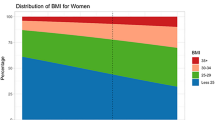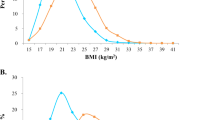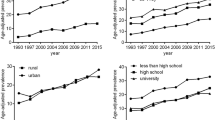Abstract
Objectives: To compare temporal changes in BMI, overweight (BMI >25 kg/m2) and obesity (BMI >30 kg/m2) between two periods, among adult Kuwaitis.
Design: Comparison of two independent cross-sectional samples of Kuwaitis studied in 1980–81 and 1993–94.
Subjects: 2067 (896 men and 1171 women) and 3435 (1730 men and 1705 women) adult Kuwaitis (aged ≥18 y), drawn from primary health care (PHC) clinics and studied for nutritional assessment and for prevalence of obesity in 1980–81 and 1993–94, respectively.
Measurements: Weight was measured in kilograms and height in meters to obtain the body mass index (BMI), which is the weight in kilograms divided by the height in meters squared (kg/m2). BMI >25 and >30 kg/m2 were classified as overweight and obesity, respectively.
Results: Mean BMI (kg/m2) increased significantly (P<0.001) by 10.0 and 6.2% (2.5 and 1.7 kg/m2) among men and women, respectively. Prevalence of overweight and obesity (BMI >25 and >30 kg/m2) increased by 20.6 and 15.4% and by 13.7 and 8.4% among men and women, respectively. After controlling for sociodemographic differences between the two study periods, mean BMI was 2.0 and 1.6 kg/m2 higher in 1993–94 than in 1980–81 among men and women, respectively. Prevalence of overweight and obesity (BMI >25 and >30 kg/m2) also increased among both genders between the two periods (OR=2.1, 95% CI 1.7–2.7 and OR=1.9, 95% CI 1.5–2.4, for men and OR=2.2, 95% CI 1.6–3.0 and OR=1.4, 95% CI–1.0–1.9, for women).
Conclusions: BMI, prevalence of overweight and obesity increased among Kuwaitis between 1980–81 and 1993–94, probably due to the effects of modernization, affluence, increased food consumption and the concomitant changes to sedentary lifestyles. The rate of temporal changes in BMI and obesity were higher, by comparison, in Kuwait than in selected other countries.
Sponsorship: none
This is a preview of subscription content, access via your institution
Access options
Subscribe to this journal
Receive 12 print issues and online access
$259.00 per year
only $21.58 per issue
Buy this article
- Purchase on Springer Link
- Instant access to full article PDF
Prices may be subject to local taxes which are calculated during checkout
Similar content being viewed by others
Author information
Authors and Affiliations
Rights and permissions
About this article
Cite this article
Al-Isa, A. Body mass index and prevalence of obesity changes among Kuwaitis. Eur J Clin Nutr 51, 743–749 (1997). https://doi.org/10.1038/sj.ejcn.1600476
Received:
Revised:
Accepted:
Issue Date:
DOI: https://doi.org/10.1038/sj.ejcn.1600476
Keywords
This article is cited by
-
Prevalence and Covariates of Obesity in Lebanon: Findings from the First Epidemiological Study
Obesity Research (2003)
-
Multiple coronary risk factors in healthy older Kuwaiti males
European Journal of Clinical Nutrition (2002)
-
Secular trends in body mass index by birth cohort in eastern Finland from 1972 to 1997
International Journal of Obesity (2001)
-
Age, education and occupation as determinants of trends in body mass index in Finland from 1982 to 1997
International Journal of Obesity (2000)



